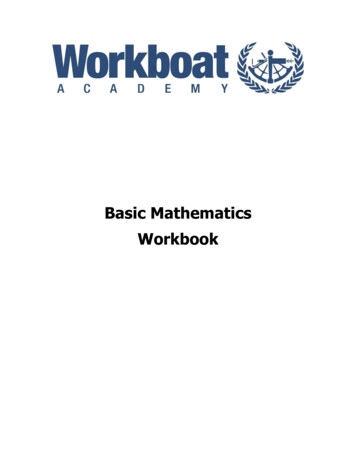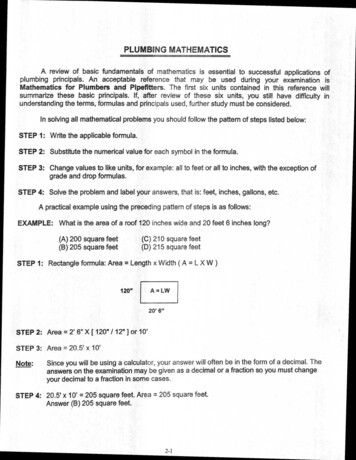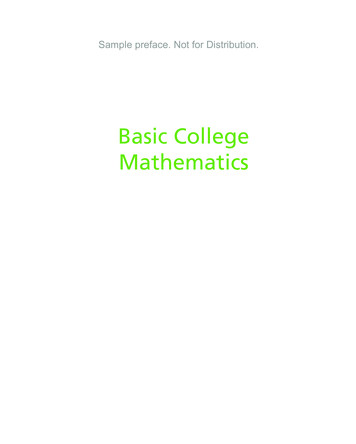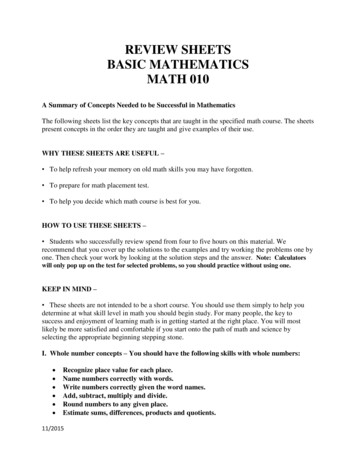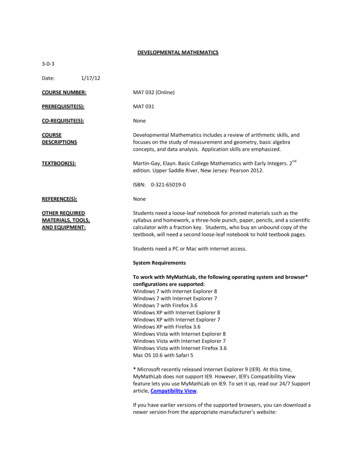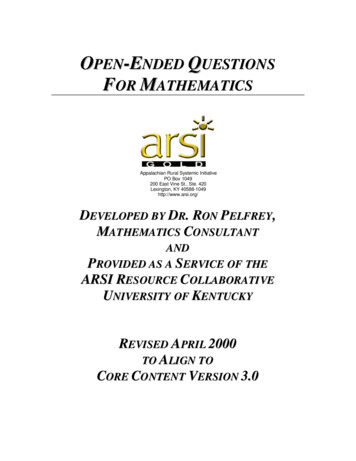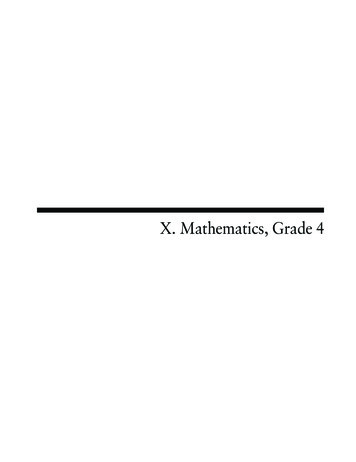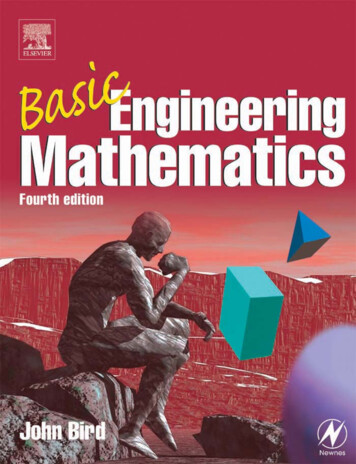
Transcription
BasicEngineeringMathematics
In memory of Elizabeth
Basic EngineeringMathematicsFourth EditionJohn Bird, BSc(Hons), CMath, CEng, FIMA, MIEE, FIIE(Elec), FCollP
NewnesAn imprint of ElsevierLinacre House, Jordan Hill, Oxford OX2 8DP30 Corporate Drive, Burlington, MA 01803First published 1999Second edition 2000Third edition 2002Reprinted 2000 (twice), 2001, 2003Fourth edition 2005Copyright 2005, John Bird. All rights reserved.The right of John Bird to be identified as the author of this work has beenasserted in accordance with the Copyright, Designs and Patents Act 1988No part of this publication may be reproduced in any material form (includingphotocopying or storing in any medium by electronic means and whetheror not transiently or incidentally to some other use of this publication) withoutthe written permission of the copyright holder except in accordance with theprovisions of the Copyright, Designs and Patents Act 1988 or under the terms ofa licence issued by the Copyright Licensing Agency Ltd, 90 Tottenham CourtRoad, London, England W1T 4LP. Applications for the copyright holder’swritten permission to reproduce any part of this publication should beaddressed to the publisherPermissions may be sought directly from Elsevier’s Science and TechnologyRights Department in Oxford, UK: phone: ( 44) (0) 1865 843830;fax: ( 44) (0) 1865 853333; e-mail: permissions@elsevier.co.uk. You mayalso complete your request on-line via the Elsevier homepage(http://www.elsevier.com), by selecting ‘Customer Support’ and then‘Obtaining Permissions’British Library Cataloguing in Publication DataA catalogue record for this book is available from the British LibraryLibrary of Congress Cataloguing in Publication DataA catalogue record for this book is available from the Library of CongressISBN 0 7506 6575 0For information on all Newnes publicationsvisit our website at www.newnespress.comTypeset by Charon Tec Pvt. Ltd, Chennai, Indiawww.charontec.comPrinted and bound in Great Britain
ContentsPrefacexi1.Basic arithmetic11.11.21.31342.Fractions, decimals and percentages2.12.22.32.43.4.5.Arithmetic operationsHighest common factors and lowest common multiplesOrder of precedence and bracketsFractionsRatio and proportionDecimalsPercentagesAssignment 166891113Indices, standard form and engineering esWorked problems on indicesFurther worked problems on indicesStandard formWorked problems on standard formFurther worked problems on standard formEngineering notation and common prefixesCalculations and evaluation of formulae214.14.24.34.42122252729Errors and approximationsUse of calculatorConversion tables and chartsEvaluation of formulaeAssignment 2Computer numbering systems305.15.25.35.45.53030313233Binary numbersConversion of binary to denaryConversion of denary to binaryConversion of denary to binary via octalHexadecimal numbers6. Algebra376.16.26.3373941Basic operationsLaws of indicesBrackets and factorization
viContents6.46.57.Fundamental laws and precedenceDirect and inverse proportionalityAssignment 3Simple equations477.17.27.37.47.54747495052Expressions, equations and identitiesWorked problems on simple equationsFurther worked problems on simple equationsPractical problems involving simple equationsFurther practical problems involving simple equations8. Transposition of formulae8.18.28.38.49.434546Introduction to transposition of formulaeWorked problems on transposition of formulaeFurther worked problems on transposition of formulaeHarder worked problems on transposition of formulaeAssignment 4545454555759Simultaneous equations609.19.29.39.49.56060626365Introduction to simultaneous equationsWorked problems on simultaneous equations in two unknownsFurther worked problems on simultaneous equationsMore difficult worked problems on simultaneous equationsPractical problems involving simultaneous equations10. Quadratic equations10.110.210.310.410.510.6Introduction to quadratic equationsSolution of quadratic equations by factorizationSolution of quadratic equations by ‘completing the square’Solution of quadratic equations by formulaPractical problems involving quadratic equationsThe solution of linear and quadratic equations simultaneously11. Inequalities11.111.211.311.411.511.6Introduction to inequalitiesSimple inequalitiesInequalities involving a modulusInequalities involving quotientsInequalities involving square functionsQuadratic inequalitiesAssignment 512. Straight line graphs12.1 Introduction to graphs12.2 The straight line graph12.3 Practical problems involving straight line graphs13. Graphical solution of equations13.1 Graphical solution of simultaneous equations13.2 Graphical solutions of quadratic 495
Contents13.3 Graphical solution of linear and quadratic equations simultaneously13.4 Graphical solution of cubic equationsAssignment 614. Logarithms14.114.214.314.4Introduction to logarithmsLaws of logarithmsIndicial equationsGraphs of logarithmic functions15. Exponential functions15.115.215.315.415.515.615.7The exponential functionEvaluating exponential functionsThe power series for exGraphs of exponential functionsNapierian logarithmsEvaluating Napierian logarithmsLaws of growth and decayAssignment 716. Reduction of non-linear laws to linear-form16.1 Determination of law16.2 Determination of law involving logarithms17. Graphs with logarithmic scales17.117.217.317.4Logarithmic scalesGraphs of the form y axnGraphs of the form y abxGraphs of the form y aekx18. Geometry and triangles18.118.218.318.418.518.6Angular measurementTypes and properties of anglesProperties of trianglesCongruent trianglesSimilar trianglesConstruction of trianglesAssignment 819. Introduction to e theorem of PythagorasTrigonometric ratios of acute anglesSolution of right-angled trianglesAngles of elevation and depressionEvaluating trigonometric ratios of any angles20. Trigonometric waveforms20.1 Graphs of trigonometric functions20.2 Angles of any magnitude20.3 The production of a sine and cosine 39141142142142143145147148151151152154
viiiContents20.4 Sine and cosine curves20.5 Sinusoidal form A sin(ωt α)Assignment 921. Cartesian and polar co-ordinates21.121.221.321.4IntroductionChanging from Cartesian into polar co-ordinatesChanging from polar into Cartesian co-ordinatesUse of R P and P R functions on calculators22. Areas of plane figures22.122.222.322.422.5MensurationProperties of quadrilateralsWorked problems on areas of plane figuresFurther worked problems on areas of plane figuresAreas of similar shapesAssignment 1023. The circle23.123.223.323.4IntroductionProperties of circlesArc length and area of a sectorThe equation of a circle24. Volumes of common solids24.124.224.324.424.5Volumes and surface areas of regular solidsWorked problems on volumes and surface areas of regular solidsFurther worked problems on volumes and surface areas of regular solidsVolumes and surface areas of frusta of pyramids and conesVolumes of similar shapesAssignment 1125. Irregular areas and volumes and mean values of waveforms25.1 Areas of irregular figures25.2 Volumes of irregular solids25.3 The mean or average value of a waveform26. Triangles and some practical applications26.126.226.326.426.526.6Sine and cosine rulesArea of any triangleWorked problems on the solution of triangles and their areasFurther worked problems on the solution of triangles and their areasPractical situations involving trigonometryFurther practical situations involving trigonometryAssignment 1227. Vectors27.1 Introduction27.2 Vector addition27.3 Resolution of 198198198198200201204206207207207209
Contents27.4 Vector subtraction27.5 Relative velocity28. Adding of waveforms28.1 Combination of two periodic functions28.2 Plotting periodic functions28.3 Determining resultant phasors by calculation29. Number sequences29.129.229.329.429.529.629.729.8Simple sequencesThe n’th term of a seriesArithmetic progressionsWorked problems on arithmetic progressionFurther worked problems on arithmetic progressionsGeometric progressionsWorked problems on geometric progressionsFurther worked problems on geometric progressionsAssignment 1330. Presentation of statistical data30.1 Some statistical terminology30.2 Presentation of ungrouped data30.3 Presentation of grouped data31. Measures of central tendency and dispersion31.131.231.331.431.5Measures of central tendencyMean, median and mode for discrete dataMean, median and mode for grouped dataStandard deviationQuartiles, deciles and percentiles32. Probability32.132.232.332.4Introduction to probabilityLaws of probabilityWorked problems on probabilityFurther worked problems on probabilityAssignment 1433. Introduction to 933.10Introduction to calculusFunctional notationThe gradient of a curveDifferentiation from first principlesDifferentiation of y axn by the general ruleDifferentiation of sine and cosine functionsDifferentiation of eax and ln axSummary of standard derivativesSuccessive differentiationRates of 3246247247247248249250252253254255255
xContents34. Introduction to integration34.134.234.334.434.5The process of integrationThe general solution of integrals of the form axnStandard integralsDefinite integralsArea under a curveAssignment 15257257257257260261265List of formulae266Answers to exercises270Index285
PrefaceBasic Engineering Mathematics, 4th Edition introduces and then consolidates basic mathematical principles and promotes awarenessof mathematical concepts for students needing a broad base for further vocational studies. In this fourth edition, new material hasbeen added on engineering notation, inequalities, graphs with logarithmic scales and adding waveforms, together with extra practicalproblems interspersed throughout the text.The text covers:(i) the Applied Mathematics content of the GNVQ mandatory unit ‘Applied Science and Mathematics for Engineering’ atIntermediate level (i.e. GNVQ 2)(ii) the mandatory ‘Mathematics for Engineering’ at Advanced level (i.e. GNVQ 3) in Engineering(iii) the optional ‘Applied Mathematics for Engineering’ at Advanced level (i.e. GNVQ 3) in Engineering(iv) the Mathematics content of ‘Applied Science and Mathematics for Technicians’ for Edexcel/BTEC First Certificate(v) the mandatory ‘Mathematics for Technicians’ for National Certificate and National Diploma in Engineering(vi) Mathematics 1 for City & Guilds Technician Certificate in Telecommunications and Electronics Engineering(vii) basic mathematics for a wide range of introductory/access/foundation mathematics courses(viii) GCSE revision, and for similar mathematics courses in English-speaking countries world-wide.Basic Engineering Mathematics 4th Edition provides a lead into Engineering Mathematics 4th Edition.Each topic considered in the text is presented in a way that assumes in the reader little previous knowledge of that topic. Theory isintroduced in each chapter by a brief outline of essential theory, definitions, formulae, laws and procedures. However, these are keptto a minimum, for problem solving is extensively used to establish and exemplify the theory. It is intended that readers will gain realunderstanding through seeing problems solved and then solving similar problems themselves.This textbook contains some 600 worked problems, followed by over 1050 further problems (all with answers – at the end of thebook). The further problems are contained within some 129 Exercises; each Exercise follows on directly from the relevant sectionof work. 260 line diagrams enhance the understanding of the theory. Where at all possible the problems mirror practical situationsfound in engineering and science.At regular intervals throughout the text are 15 Assignments to check understanding. For example, Assignment 1 covers materialcontained in chapters 1 and 2, Assignment 2 covers the material contained in chapters 3 and 4, and so on. These Assignments donot have answers given since it is envisaged that lecturers could set the Assignments for students to attempt as part of their coursestructure. Lecturers may obtain a complimentary set of solutions of the Assignments in an Instructor’s Manual available from thepublishers via the internet – see below.At the end of the book a list of relevant formulae contained within the text is included for convenience of reference.‘Learning by Example’ is at the heart of Basic Engineering Mathematics 4th Edition.John BirdDefence College of Electro-Mechanical Engineering, HMS Sultan,formerly University of Portsmouth and Highbury College, PortsmouthInstructor’s ManualAn Instructor’s Manual containing the full worked solutions for all the Assignments in this book is available for download for lecturers only. To obtain a password please e-mail J.Blackford@Elsevier.com with the following details: course title,number of students, your job title and work postal address. To download the Instructor’s Manual use the following direct 0665750
This page intentionally left blank
1Basic arithmeticThus 27 74 81 19 151.1 Arithmetic operationsWhole numbers are called integers. 3, 5, 72 are called positive integers; 13, 6, 51 are called negative integers. Betweenpositive and negative integers is the number 0 which is neitherpositive nor negative.The four basic arithmetic operators are: add ( ), subtract ( ),multiply ( ) and divide ( )For addition and subtraction, when unlike signs are togetherin a calculation, the overall sign is negative. Thus, adding minus4 to 3 is 3 4 and becomes 3 4 1. Like signs togethergive an overall positive sign. Thus subtracting minus 4 from 3 is3 4 and becomes 3 4 7. For multiplication and division,when the numbers have unlike signs, the answer is negative, butwhen the numbers have like signs the answer is positive. Thus3 4 12, whereas 3 4 12. Similarly44 33and 44 33Problem 1. Add 27, 74, 81 and 19This problem is written as 27 74 81 19Adding the positive integers:Sum of positive integers is:Adding the negative integers:Sum of negative integers is:2781108741993Taking the sum of the negative integers from the sum of thepositive integers gives:108 9315Problem 2.Subtract 89 from 123This is written mathematically as 123 89123 8934Thus 123 89 34Problem 3.Subtract 74 from 377This problem is written as 377 74. Like signs together givean overall positive sign, hence377 74 377 74377 74451Thus 377 74 451Problem 4.Subtract 243 from 126The problem is 126 243. When the second number is largerthan the first, take the smaller number from the larger and makethe result negative.Thus 126 243 (243 126)243 126117Thus 126 243 117Problem 5.Subtract 318 from 269
2Basic Engineering Mathematics 269 318. The sum of the negative integers is269 318587Thus 269 318 587When dividing by numbers which are larger than 12, it is usualto use a method called long division. 2714 37828989800(2) 2 14 (4) 7 14 Problem 6.Multiply 74 by 13Thus 378 14 27This is written as 74 13Adding:7413222740962Problem 10. 74 3 74 10Thus 74 13 962Problem 7.(1) 14 into 37 goes twice.Put 2 above the 7 of 378.(3) Subtract. Bring down the8. 14 into 98 goes 7 times.Put 7 above the 8 of 378.(5) Subtract.Multiply by 178 by 46When the numbers have different signs, the result will be negative. (With this in mind, the problem can now be solved bymultiplying 178 by 46)17846106871208188Divide 5669 by 46This problem may be written as5669or 5669 46 or465669/46Using the long division method shown in Problem 9 gives: 12346 5669461069214913811As there are no more digits to bring down,5669 46 123, remainder 11or1231146Thus 178 46 8188 and 178 ( 46) 8188Now try the following exerciseProblem 8.Divide l043 by 7Exercise 1When dividing by the numbers 1 to 12, it is usual to use a methodcalled short division. 1497 103 46 37 into 10 goes 1, remainder 3. Put 1 above the 0 of 1043and carry the 3 remainder to the next digit on the right,making it 34;Step 2.7 into 34 goes 4, remainder 6. Put 4 above the 4 of 1043and carry the 6 remainder to the next digit on the right,making it 63;7 into 63 goes 9, remainder 0. Put 9 above the 3 of 1043.Thus 1043 7 149Problem 9.In Problems 1 to 21, determine the values of the expressionsgiven:1. 67 82 34Step 1.Step 3.Further problems on arithmetic operations(Answers on page 270)Divide 378 by 142. 124 273 481 3983. 927 114 182 183 2474. 2417 487 2424 1778 47125. 38419 2177 2440 799 28346. 2715 18250 11471 1509 1132747. 73 578. 813 ( 674)9. 647 87210. 3151 ( 2763)11. 4872 4683
Basic arithmeticfactor (HCF) is the largest number which divides into two ormore numbers exactly.A multiple is a number which contains another number anexact number of times. The smallest number which is exactlydivisible by each of two or more numbers is called the lowestcommon multiple (LCM).12. 23148 4772413. 38441 5377414. (a) 261 715. (a) 783 11(b) 462 9(b) 73 2416. (a) 27 38 (b) 77 2917. (a) 448 233(b) 143 ( 31)18. (a) 288 6 (b) 979 118961813(b)19. (a)71621432(b) 15904 5620. (a)4788738(b) 46857 7921. (a)18722. A screw has a mass of 15 grams. Calculate, in kilograms,the mass of 1200 such screws.23. Holes are drilled 35.7 mm apart in a metal plate. If a rowof 26 holes is drilled, determine the distance, in centimetres, between the centres of the first and last holes.24. Calculate the diameter d and dimensions A and B forthe template shown in Figure 1.1. All dimensions are inmillimetres.Problem 11. Determine the HCF of the numbers 12, 30and 42Each number is expressed in terms of its lowest factors. This isachieved by repeatedly dividing by the prime numbers 2, 3, 5, 7,11, 13 . . . (where possible) in turn. Thus12 2 2 330 2 3 542 2 3 7The factors which are common to each of the numbers are 2 incolumn 1 and 3 in column 3, shown by the broken lines. Hencethe HCF is 2 3, i.e. 6. That is, 6 is the largest number whichwill divide into 12, 30 and 42.Problem 12. Determine the HCF of the numbers 30, 105,210 and 1155110BUsing the method shown in Problem 11:30 2 3 512105 d3 5 7210 2 3 5 7A1155 603 5 7 11The factors which are common to each of the numbers are 3 incolumn 2 and 5 in column 3. Hence the HCF is 3 5 15.3850Problem 13.and 90Determine the LCM of the numbers 12, 42120Fig. 1.1The LCM is obtained by finding the lowest factors of each ofthe numbers, as shown in Problems 11 and 12 above, and thenselecting the largest group of any of the factors present. Thus12 2 2 31.2 Highest common factors and lowestcommon multiplesWhen two or more numbers are multiplied together, the individual numbers are called factors. Thus a factor is a numberwhich divides into another number exactly. The highest common42 2 390 2 3 3 5 7The largest group of any of the factors present are shown by thebroken lines and are 2 2 in 12, 3 3 in 90, 5 in 90 and 7 in 42.
4Basic Engineering MathematicsHence the LCM is 2 2 3 3 5 7 1260, and is thesmallest number which 12, 42 and 90 will all divide into exactly.(ii) 2 3 3 2, i.e. the order of numbers when multiplyingdoes not matter;(iii) 2 (3 4) (2 3) 4, i.e. the use of brackets whenadding does not affect the result;Problem 14. Determine the LCM of the numbers 150, 210,735 and 1365Using the method shown in Problem 13 above:(vii) 2[3 (4 5)] 2[3 20] 2 23 46, i.e. when anexpression contains inner and outer brackets, the innerbrackets are removed first.210 2 3 5 71365 3 5 7 73 5 7(v) 2 (3 4) 2(3 4) 2 3 2 4, i.e. a number placedoutside of a bracket indicates that the whole contents of thebracket must be multiplied by that number;(vi) (2 3)(4 5) (5)(9) 45, i.e. adjacent brackets indicatemultiplication;150 2 3 5 5735 (iv) 2 (3 4) (2 3) 4, i.e. the use of brackets whenmultiplying does not affect the result; 13Problem 15.Find the value of 6 4 (5 3)The LCM is 2 3 5 5 7 7 13 95550Now try the following exerciseThe order of precedence of operations is remembered by the wordBODMAS.ThusExercise 26 4 (5 3) 6 4 2Further problems on highest commonfactors and lowest common multiples(Answers on page 270)In Problems 1 to 6 find (a) the HCF and (b) the LCM of thenumbers given:1. 6, 10, 142. 12, 30, 453. 10, 15, 70, 1054. 90, 105, 3005. 196, 210, 910, 4626. 196, 350, 770Problem 16. 6 2(Division) 8(Addition)Determine the value of13 2 3 14 (2 5)13 2 3 14 (2 5) 13 2 3 14 71.3 Order of precedence and bracketsWhen a particular arithmetic operation is to be performed first,the numbers and the operator(s) are placed in brackets. Thus 3times the result of 6 minus 2 is written as 3 (6 2). In arithmeticoperations, the order in which operations are performed are:Problem 17.(B) 13 2 3 2(D) 13 6 2(M) 15 6(A) 9(S)Evaluate16 (2 6) 18[3 (4 6) 21](i) to determine the values of operations contained in brackets;(ii) multiplication and division (the word ‘of’ also meansmultiply); and(Brackets)16 (2 6) 18[3 (4 6) 21](iii) addition and subtraction. 16 (2 6) 18[3 24 21)(B)This order of precedence can be remembered by the wordBODMAS, standing for Brackets, Of, Division, Multiplication,Addition and Subtraction, taken in that order.The basic laws governing the use of brackets and operators areshown by the following examples: 16 8 18 6(B) 2 18 6(D) 2 108(M) 110(A)(i) 2 3 3 2, i.e. the order of numbers when adding doesnot matter;
Basic arithmeticNow try the following exerciseProblem 18.Find the value of23 4(2 7) (144 4)(14 8)Exercise 3Further problems on order of precedenceand brackets (Answers on page 270)Simplify the expressions given in Problems 1 to 7:36(144 4) 23 4 14 23 4(2 7) (14 8)6 23 4 14 6(B)(D) 23 56 6(M) 29 56(A) 27(S)1. 14 3 152. 17 12 43. 86 24 (14 2)4. 7(23 18) (12 5)5. 63 28(14 2) 266.112 119 17 (3 19)167.(50 14) 7(16 7) 735
2Fractions, decimals and percentages2.1 FractionsWhen 2 is divided by 3, it may be written as 23 or 2/3. 23 iscalled a fraction. The number above the line, i.e. 2, is called thenumerator and the number below the line, i.e. 3, is called thedenominator.When the value of the numerator is less than the value of thedenominator, the fraction is called a proper fraction; thus 23 is aproper fraction. When the value of the numerator is greater thanthe denominator, the fraction is called an improper fraction.Thus 73 is an improper fraction and can also be expressed as amixed number, that is, an integer and a proper fraction. Thusthe improper fraction 73 is equal to the mixed number 2 13 .When a fraction is simplified by dividing the numeratorand denominator by the same number, the process is calledcancelling. Cancelling by 0 is not permissible.Problem 1.Simplify13 27The LCM of the two denominators is 3 7, i.e. 21.Expressing each fraction so that their denominators are 21, gives:1 21 7 2 376 3 73 7 7 321 21 137 6 2121Thus1 2 7 6 13 as obtained previously.3 72121Problem 2.Find the value of 3 23 2 16One method is to split the mixed numbers into integers and theirfractional parts. Then 121122 2 3 2 3 2 3 3636364 131 1 1 16 662Another method is to express the mixed numbers as improperfractions.2 9 2 119Since 3 , then 3 33 3 331 12 1 13 Similarly, 2 66661 11 13 22 13 912 1 as obtainedThus 3 2 36366662previously.Alternatively:Step(2)Step(3) (7 1) (3 2)1 2 3 721 Step(1)Step 1: the LCM of the two denominators;Step 2: for the fraction 13 , 3 into 21 goes 7 times, 7 thenumerator is 7 1;Step 3: for the fraction 27 , 7 into 21 goes 3 times, 3 thenumerator is 3 2.Problem 3.Evaluate 7 18 5 37 13317 5 7 5 87871 37 1 8 3 2 2 8 756317 5 87
Fractions, decimals and percentages 2 177 24 2 5656 2 112 17112 1717 56565656 Multiplying both numerator and denominator by the reciprocalof the denominator gives:12 1 3 331 7 2 4 4 37 1 112141 22 11 212 11 21 1 33995 15656Problem 4.Determine the value of 4 58 3 14 1 251254 3 1 (4 3 1) 845 5 1 2 8 4 5 5 5 10 1 8 24025 10 16 2 403131 2 24040This method can be remembered by the rule: invert the secondfraction and change the operation from division to multiplication.Thus:1332 13 12 as obtained previously. 7 211 2447 1 3 2 Problem 5.Find the value of3 14 7 15Problem 8.Dividing numerator and denominator by 3 gives: 3 14 1 14 1 1471 55757 5 Dividing numerator and denominator by 7 gives:121 421 21 1 557 51 This process of dividing both the numerator and denominator ofa fraction by the same factor(s) is called cancelling.Evaluate 1 35 2 13 3 37Mixed numbers must be expressed as improper fractions beforemultiplication can be performed. Thus, 35 336 121 311 2 3 375 53 3775 8 1 8 1 872 4 5 1 5 1 1371 644 12558Problem 7.Simplify33 127 127 21213 12 7 21Find the value of 5 35 7 13The mixed numbers must be expressed as improper fractions.Thus,143128 223422 8 5 7 5353522 11 55 Problem 9.Problem 6.7Simplify13 25 14 38 13The order of precedence of operations for problems containing fractions is the same as that for integers, i.e. rememberedby BODMAS (Brackets, Of, Division, Multiplication, Additionand Subtraction). Thus, 12 13 1 35 48 3 1 4 2 5 131 2032 48 13182 2 03 5 11 26 53(5 1) (3 26) 1513 73 4 1515 (B)(D)(M)(S)Problem 10. Determine the value of 113171of 3 2 5 6248 16 2 113171of 3 2 5 6248 16 2 1 41317of 1 64816 2(B)
8Basic Engineering Mathematics 317 5 41 6 4816 2(O)13. 17 5 41 1 62 6 43281 (D) 35 82 1 243214. If a storage tank is holding 450 litres when it is threequarters full, how much will it contain when it is twothirds full?(M)35 656 1 242(A) 691 1 242(A) 691 1224(S)7679 28 2424Now try the following exerciseExercise 4Further problems on fractions (Answerson page 270)Evaluate the expressions given in Problems 1 to 13:1 21. (a) 2 571(b) 16 4322. (a) 7 112 1 2(b) 9 7 312 134 2 1 3 4 13515. Three people, P, Q and R contribute to a fund, P provides3/5 of the total, Q provides 2/3 of the remainder, andR provides 8. Determine (a) the total of the fund, (b)the contributions of P and Q.2.2 Ratio and proportionThe ratio of one quantity to another is a fraction, and is the numberof times one quantity is contained in another quantity of thesame kind. If one quantity is directly proportional to another,then as one quantity doubles, the other quantity also doubles.When a quantity is inversely proportional to another, then asone quantity doubles, the other quantity is halved.Problem 11.Divide 126 in the ratio of 5 to 13.Because the ratio is to be 5 parts to 13 parts, then the total numberof parts is 5 13, that is 18. Then,18 parts correspond to 126126 7,1 part corresponds to18333. (a) 5 313452(b) 4 385Hence234. (a) 10 873145(b) 3 4 14565 parts correspond to 5 7 35 and 13 parts correspond to13 7 911715 35 119(Check: the parts must add up to the total 35 91 126 thetotal.)5. (a)3 5 4 96. (a)23 7 15 97(b)(b)351 17. (a) 4 11398. (a)9.3 45 8 641374 4 317113934(b) 14515(b) 1 2391 3 16 3 4 27911 3 2 5 15 3 573 15of 15 11. 1574 1610.1 2 1 3 212. 4 3 3 5 7Problem 12. A piece of timber 273 cm long is cut into threepieces in the ratio of 3 to 7 to 11. Determine the lengths ofthe three pieces.The total number of parts is 3 7 11, that is, 21. Hence 21parts correspond to 273 cm3 parts correspond to273 13 cm213 13 39 cm7 parts correspond to7 13 91 cm1 part corresponds to11 parts correspond to 11 13 143 cmi.e. the lengths of the three pieces are 39 cm, 91 cm and 143 cm.(Check: 39 91 143 273)
Fractions, decimals and percentagesProblem 13. A gear wheel having 80 teeth is in mesh witha 25 tooth gear. What is the gear ratio?80 16 3.2255i.e. gear ratio 16:5 or 3.2:1Gear ratio 80 : 25 Problem 14.Express 25p as a ratio of 4.25 lWorking in quantities of the same kind, the required ratio is25425i.e.1171th of 4.25. This may be written either as:1725:425: :1:17 (stated as ‘25 is to 425 as 1 is to 17’) or as94. When mixing a quantity of paints, dyes of four differentcolours are used in the ratio of 7:3:19:5. If the mass ofthe first dye used is 3 12 g, determine the total mass of thedyes used.5. Determine how much copper and how much zinc isneeded to make a 99 kg brass ingot if they have to bein the proportions copper:zinc: :8:3 by mass.6. It takes 21 hours for 12 men to resurface a stretch of road.Find how many men it takes to resurface a similar stretchof road in 50 hours 24 minutes, assuming the work rateremains constant.7. It takes 3 hours 15 minutes to fly from city A tocity B at a constant speed. Find how long the journeytakes if:That is, 25p is(b) if the speed is three-quarters of the original speed.251 425 17Problem 15. An alloy is made up of metals A and B in theratio 2.5:1 by mass. How much of A has to be added to 6 kgof B to make the alloy?Ratio A:B: :2.5:1 i.e.When B 6 kg,A 2.5 2.5B1A 2.5 from which, A 6 2.5 15 kg6Problem 16. If 3 people can complete a task in 4 hours,find how long it will take 5 people to complete the sametask, assuming the rate of work remains cons
Basic Engineering Mathematics Fourth Edition John Bird,BSc(Hons), CMath, CEng, FIMA, MIEE, FIIE(Elec), FCollP. prelims 9/2/2005 10: 51 page iv Newnes An imprint of Elsevier Linacre House, Jordan Hill, Oxford OX2 8DP 30 C
